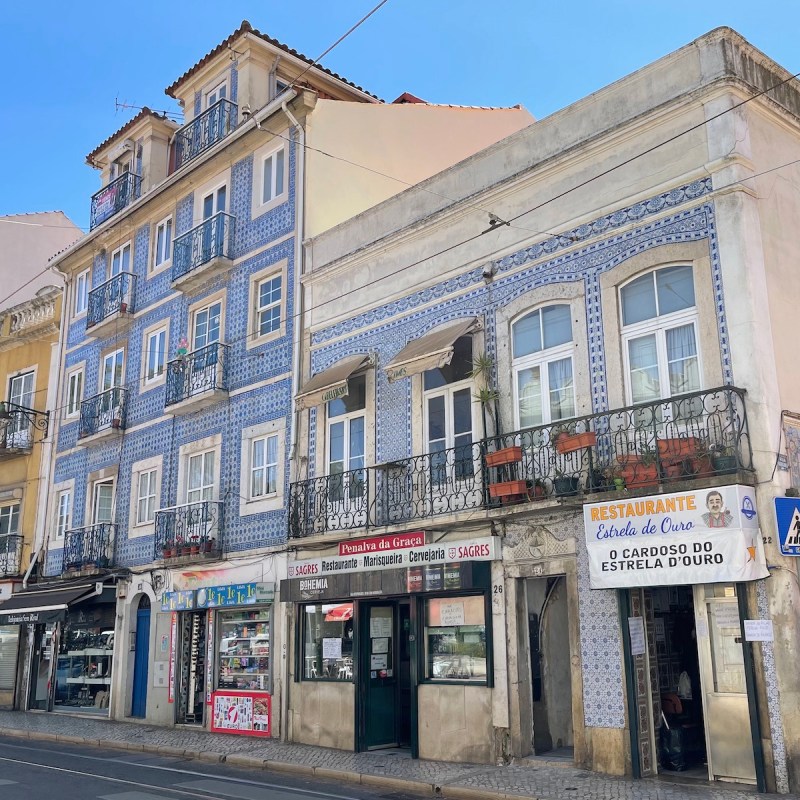
Images of Portugal often include the colorful glazed tiles found throughout the country. Azulejos, as these tiles are called, have been prominent in Portugal since the 1700s. Their inspiration came from the Moorish influence of invaders in Spain and Portugal as early as the 13th century.
Videos by TravelAwaits
The word azulejo comes from Arabic, meaning “little polished stone.” Appearing on the exteriors and interiors of structures like churches, markets, train stations, and government buildings, they carry with them a meaningful history and deep connection to the Portuguese identity. Over the centuries, azulejos have evolved and spread so that an infinite variety can be found all over the country. Here’s the story behind Portugal’s colorful tiles and some of the best places to see them.

History Of Portugal’s Colorful Tiles
King Manuel I, known as “the Fortunate,” ruled over great expansion and formation of the Portuguese Empire. When he visited Granada, Spain and saw the stunning Alhambra palace with its colorful tiles, he brought back the idea of using tiles to embellish empty walls in Portuguese architecture. The tiles of this time were simple geometric shapes in accordance with religious law, but as they grew in popularity and laws changed, so did the azulejos.
As time marched on, the azulejos evolved. In the 17th century, azulejo designs were influenced by the famous blue-and-white tiles of Delft in the Netherlands. The Portuguese elite loved the blue and white tiles and bought them from Amsterdam until King Pedro III of Portugal put a halt on the imports. He wanted Portugal to produce azulejos in the country and so began the domestic production of Portuguese azulejos.
The 18th century was a golden age for the mass production of azulejos in Portugal. The Portuguese, known for telling stories, used the tiles as a way to create public artworks that were not only beautiful but also communicated everything from history to culture. Tiles included depictions of nature and scenes of human life, and ultimately became more colorful and immensely popular. Entire ceilings and walls have been assembled to impart history and tell tales.
Best Places To See Portugal’s Tiles
As beautiful as they are, azulejos also help keep indoor temperatures cooler during hot Portugal summers. The weather-resistant tile surfaces protect against deterioration from wetness in the winters. It’s no surprise that these days, azulejos can be found just about anywhere in Portugal telling stories, brightening up the scenery, and protecting people inside buildings as well as the buildings themselves. Although it would be hard to visit Portugal and not run into azulejos, here are some special places to consider.

1. Porto
Porto is the second largest city in Portugal (after Lisbon) and one of the most beautiful. In addition to its vibrant culture and distinctive attractions, Porto is home to some stunning examples of azulejos. São Bento Railway Station is top of the list for those looking for unique examples of the storytelling tiles. Celebrated as one of the most beautiful train stations in the world, São Bento’s vestibule walls are covered with tiles showing important events in Portuguese history. Taking over a decade to complete, there are 20,000 tiles of various events including important battles. Among other great spots to see beautiful azulejos is the impressive Capela das Almas or “Chapel of Souls.” It has almost 16,000 blue and white tiles displaying scenes from the lives of saints, including Saint Francis of Assisi and Saint Catherine, the patron saints of the chapel. No wonder this is a favorite for photographs in Porto.

2. Lisbon
The capital city is bursting with azulejos. Just walking the streets through many neighborhoods will provide a variety of examples. But if you want to get colorful tiles in serious doses, there are also a few extra special places worth seeing. Fronteira Palace was originally built as a summer home for the Marquis of Fronteira and his wife. However, when the great earthquake of 1755 destroyed their main residence in Lisbon, this property was expanded and became the family’s main home. Several beautiful façades and the gallery of the arts terrace are great examples of azulejos. Inside the palace, the Room of Battles displays important military battles of the time. Other rooms use azulejos to show off the homeowner’s wealth and good taste. The National Azulejo Museum is located inside a convent built by Queen Leonor, which itself contains beautiful azulejos. The museum shows the history of azulejos and takes visitors through their unique evolution and development over time. The Bairro Alto neighborhood is quite colorful and fun to walk through as well.

3. Aveiro
Not only is Aveiro one of our favorite cities in Portugal, it is also a great place to see azulejos. Aveiro is sometimes called the “Venice of Portugal” because of its colorful moliceiro boats that are similar to gondolas and the central canals on which they float. But for lovers of tile, the city is full of even more delights. The old train station is a good place to start, with scenes of local activities and workers in the area going about their activities in traditional work clothes. Art Nouveau is highly visible in the city’s buildings, and some of the most delightful examples of azulejos can be found there as well. The Misericórdia Church offers another good spot to see beautiful tiles.

4. Carcavelos
Lisboetas (Lisbon residents) flock to Carcavelos on the Estoril Coast in the summer for its amazingly wide and long beach, perfect to beat the heat of the city. But Carcavelos also happens to have a lot to satisfy azulejos lovers as well. The Cerâmica Artistica de Carcavelos is an azulejos factory that has a store you can visit. If you have a hankering to get something custom-made, they will be all too happy to help you. They also do restoration work on azulejos in churches and buildings around the city. One fine example is the Parish Church of Carcavelos. In it are azulejos depicting St. Francis’s stigmata, the Magi, the Passion of Christ, and St. Anthony’s sermon. These tiles were originally created by Gabriel del Barco, the 17th-century Spanish painter instrumental in the development of azulejos in Portugal.

5. Madeira
The island of Madeira is a gorgeous place to visit. Aside from the many things to do, lush vegetation, blue skies, and beautiful seaside restaurants, there are also plenty of azulejos tiles to enjoy. Start with the first stop when arriving at Madeira Airport in Funchal. Although it has a tricky location with a unique runway, it also has some beautiful azulejo tiles to enjoy when you arrive or leave. Also known as Cristiano Ronaldo International Airport, named after arguably the most popular soccer player in the world, it’s fair to say that this is one spot where there’s plenty of show and go. Another fabulous spot to see azulejo tiles is the Mercado dos Lavradores, the farmers market in the center of Funchal. Tile panels depicting scenes of the region cover the main entrance, façade, and the fish market.

6. Sintra
In the 10th century when Portugal was under Moorish control, the Sintra National Palace was the governor’s home and filled with very early azulejos which disappeared over the years. The palace then became home to eight kings, including Manuel I, who brought back azulejos from Spain. Azulejos still hold a prominent place in the palace and around Sintra today. The beautiful park surrounding the palace is also a great place to see some fabulous tilework. Fountains, walls, and arches display azulejos including geometric designs and nature scenes, great inspiration for taking some amazing hikes on trails in the area.

7. Cascais
We would be remiss if we didn’t mention the azulejos in our neck of the Portuguese woods. So, we’ll finish off with a recommendation not only to visit the wonderful restaurants and beaches of Cascais, but also to do a little wandering to look at the tiles. It’s pretty easy to find them, and the beautiful City Hall façade is a perfect example. As you walk around enjoying the sea breeze, you might also stop by the Church of Our Lady of Assumption for another great example. One final stop, which is lots of fun on Wednesdays and Saturdays when it is full of farmers selling fresh produce and goods, is the Mercado da Vila. There are large blue and white panels depicting, appropriately enough, scenes of farming and farmers. We also see azulejos on buildings around Parque Marechal-Carmona as well as on many streets as we enjoy a stroll along winding back streets and roads with beach views.
Pro Tip: There’s a fun board game for fans of azulejo tiles called Azul that lets you decorate your own palace with beautiful azulejo tiles.
The colorful tiles called azulejos are a meaningful part of Portugal’s culture and history. They provide an important link to the past as well as an interesting lens for the country’s development. Not only have the styles and uses of the tiles changed over the centuries, but the displays themselves often tell significant stories — from heroic battles to the everyday work of average citizens. While enjoying the beauty of Portugal that envelops you as you explore, take a little time to seek out these living artworks. They’ll give you an even deeper sense of the Portuguese people and their way of appreciating cultural elements from elsewhere and making them undeniably their own.
